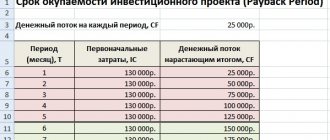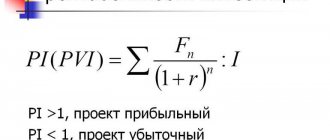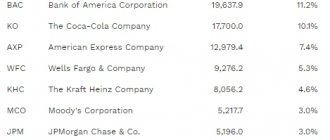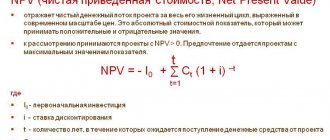Discounted payback period (DPP) is one of the most important parameters taken into account when deciding whether to participate in a particular project. This period indicator is used by experts to determine how soon the planned financial income will cover all financial costs at the investment offset stage. A short time interval indicates higher prospects for the project.
Payback: brief description
Universal examples of calculating the discount period are widely in demand among professionals, because thanks to them you can find out how long it will take to return the investment amount from the project business. Experts take into account only the net financial flow. Experts argue that to assess the payback and efficiency of an investment project, DPP must be calculated. You can obtain reliable data if you sequentially subtract discounted financial proceeds from the starting costs of the business plan. Thanks to this, it is possible to cover all investment expenses of the term.
The universality of discounted financial flows helps to understand how the value of money changes over time. Specialists can take into account all changes in the purchasing power of finance. This approach is practically irreplaceable if there is instability in national currencies.
The discounted period DPP formula is actively used by professionals to calculate payback time. The final data for the term are as accurate as possible, since experts can take into account the expected inflation component and the rate of return, which is most in demand by investors. If you take into account all these parameters of the discount period, you can determine the payback of the business project.
In economic literature, the discounted term for deposits is called by many terms: PresentValuePayback, DiscountedPaybackPeriod, DPP and PVP, as well as DPB.
Key Features
Methods for calculating discounted time take into account a range of nuances. The key to the deadline is the prohibition of using in calculations ∑ net financial flow generated after the completion of the payback stage of investments. For example, a business plan assumes a long-term return of funds, but even after this time has expired, you can get much more income.
The second feature is the intensity of the impact on the formation of the time stage between the start of a business and commissioning. The highest rate of return on a business plan is achieved if enough time is allocated for the implementation of the idea. In addition, the final term may fluctuate due to changes in the rate. A high discount rate, when calculating the initial figures, will most likely lead to an increase in the final figure.
When rotating investment projects, the payback range periods are used as auxiliary ones. The obtained discounted interval data can be regarded as the time during which capital investment in a business project will give the investor identical ∑ financial flows.
Terms of the barrier rate and its calculation
This discounted payback parameter reflects the minimum ∑ profit per cu, which suits the investor and takes into account risks. In other words, for any investor the barrier rate figure is equal to the cost of financial capital, which is why the final expectations for the future profitability of different investors are individual. In addition, the data obtained for payback is assumed to be static (for the entire calculated period) or changeable.
Experts have developed several basic methods for calculating the barrier type rate:
- Use for timing in discounting inflation figures. The payback method is acceptable for so-called risk-free investments.
- Calculation of the discounted time barrier rate taking into account all past periods and a mandatory forecast for trend directions. This approach is relevant when statistics on similar deposit conditions have been accumulated.
- Experts equate the barrier rate to the cost of investment capital. In practice, this calculation method of timing shows how the investor equates the payback benefit of a possible business plan with the figures of the deposits made. In some cases, the expert may take into account the possibility of attracting external financial sources for a discounted period.
- If we are talking about unique financial deposits that do not have statistics, and there are also large risks, a unique calculation method can be used.
You can find out the discounted payback period using the formula: r = rb + (n*Ri)/i=1.
Specialists must use data such as:
- r—barrier type rate;
- rb is the risk-free figure of the Ministry of Profit;
- n is the exact number of payback time periods;
- i — risk number in ordinal value;
- R i is the accrued bonus of a certain risk.
The correct discounted calculation takes into account all the risks of the business plan: from commercial and production to monetary and financial.
Example of DPP calculation
Let's consider a simplified example with the following initial data: an amount of 2.2 million rubles was invested in the project. It is expected that it will generate income annually in three tranches: 1 million rubles, 2.5 million rubles. and 4 million rubles.
The discount factor R is adopted at a rate of 11%.
We produce the amount of DP income in the table:
| Period number i | Income, million rubles | Discounted income according to the formula | Amount of discounted income, million rubles. |
| 1 | 1 | = 1 / | 0,90 |
| 2 | 2,5 | = 2,5 / | 1,62 |
| 3 | 4 | = 4 / | 2,19 |
| Total, million rubles | 4,71 | ||
The discounted payback period is calculated based on the average annual amount of incoming cash flow received as a result of previous operations.
Where:
- DPSG – average annual incoming cash flow;
- i – number of the financing period;
- DPi – the amount of incoming cash flow number i ;
- N – number of incoming investment tranches.
Using the formula given at the very beginning of the article, you can get the approximate payback period of the project:
Which is approximately 1 year and 5 months. During this period, the investor will return the invested funds taking into account discounting.
This method, along with the advantage expressed by the simplicity of calculations, also has a disadvantage - low accuracy.
The self-recoupment graph of an investment, which can be constructed in Excel, is more clearly demonstrated.
Download Excel file with formulas
To begin with, a table is generated with the number of periods and incoming cash flows. In this case, income is summed up by a cumulative total:
| Period number i | Income, million rubles | Amount of discounted income, million rubles. | Total income for each period |
| 1 | 1 | 0,90 | 0,90 |
| 2 | 2,5 | 1,62 | 2,52 |
| 3 | 4 | 2,19 | 4,71 |
By choosing a linear chart type and drawing a horizontal line corresponding to the investment amount, you can find the discounted payback period. It will correspond to a point on the time axis corresponding to the intersection of two lines.
The graph demonstrates that the return on investment, determined graphically, will occur somewhat later - after 1 year and 7 months. This forecast is relatively pessimistic, but it can already be considered real.
Discounted period: pros and cons
The payback formula used to study the timing of discounted returns includes many advantages. Compared to academic methods, DPP displays updated deadline figures. Skillful use of the discounting parameter helps make corrections, maximizing the final result.
Discounting gives a specialist a more flexible assessment of the payback and efficiency of an investment project, thanks to which it is possible to approximately assess all existing risks. If a country cannot boast of a stable economic, tax and political situation, then the use of this indicator will help to minimize the financial risks of recoupment.
For example, when calculating the discount period, when the intensity of demand for domestic oil consumption exceeds the rate of restoration of fossil resources, then in the long and medium term all investments in field development can easily pay off.
A completely opposite situation in calculating discounted time is observed in the well-developed field of information technology. Here, there is always active competition in deadlines, and the level of software is constantly growing. This trend requires financial investments to have the fastest possible return time.
Sometimes the discounted return of finance is assessed as unsatisfactory. In particular: payback under DPP does not include the volume and vector of financial investments by time frame. The result of the calculations is completely independent of the distribution of financial flow. It is this nuance that plays an important role for specialists who are involved in assessing the company’s effectiveness.
Disadvantages include the fact that discounting cannot be used to determine the size of financial flows after the return on investment point has been reached. The standard formula for determining DPP is relevant only from the moment the money is injected until the profit is received, which can cover the amount of the deposit.
How the indicator is calculated: formula with explanations
The discounted profit formula for the entire payback period of a DPP investment given above assumes that its value is calculated for each period separately, and then the data is summed up. These operations are labor-intensive, especially with a large number of financing episodes.
It makes sense to automate them using an available tool. To achieve your goals, you need to create an analytical table for assessing the effectiveness of investments in Excel or use an online calculator.
Discounted period: distinctive parameters
The traditional use of the term DPP is considered among analysts to be the simplest option. To correctly calculate the timing, specialists do not necessarily need to use auxiliary coefficients, and the usual payback period perfectly reflects the period during which net profit can completely cover the amount of capital. The final data should not depend on changes in the economic environment and other conditions.
The practice of discounted calculations shows that the usual return period is often artificially reduced. This payback situation arises when, when calculating the period, a specific investment project is studied in isolation, without taking into account the influence of various factors. In rare cases, complete independence of a business plan from the external environment can cause failure, bankruptcy and loss of finances.
The universal DPP of an investment project helps to clearly understand the repayment period. In the universal payback formula there is an elementary indicator of discounted return, due to which the structure of financial resources is adjusted and brought to the most favorable indicator.
Over many years, the practical implementation of an approved investment project often simply loses some of its value (if the inflation rate increases or negative general economic factors influence it). If an expert, based on discounted payback figures, uses an additional indicator, this will allow him to take into account all the features of discounting and make appropriate adjustments to the calculations. The final result will be more accurate.
DPP is widely used in the financial industry, where it is simply impossible to do without a long repayment period. But standard discounting is more suitable for short-term investments. It is impossible to say unambiguously which of these parameters is better.
Using simple DPB
This discounted indicator reflects the period during which ∑ of the net financial flow of a business project will cover ∑ of investments. Total figures are taken in years or months. The typical payback period among specialists is considered a basic indicator, since with its help you can quickly evaluate a business and make an adequate decision whether to invest money or abstain.
If we are talking about the medium term, and the final payback is over the acceptable 5 years, then the final summary will be negative. The chances of accepting a business project increase significantly when investment expectations and the financial payback period coincide. Experts often have to use the discounted time period with the formula:
PP= Ko/KF сг, here:
- RR - term.
- Ko is the total ∑ of the primary investments.
- KF сг - average annual financial receipts of a business project after achieving the planned volumes.
This formula is ideal for business ideas with a discounted period, when entered into, two mandatory payback conditions will be met:
- The final income of a new business is as uniform as possible.
- All investments are made at the moment when specialists have just begun to implement the project.
Bottom line
The payback period is one of the most important indicators for an entrepreneur who plans to invest his own funds and chooses from a number of possible projects. At the same time, it is up to the investor to decide exactly how to make the calculations. In this article, we analyzed two main solutions and looked at examples of how the numbers will change in the same situation, but with different levels of indicators.
Additional materials on our website: “Law on the Protection of Consumer Rights and Return of Goods.”











